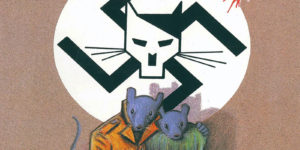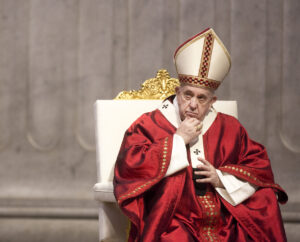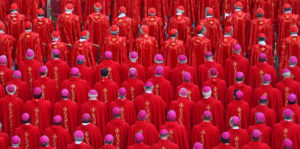Just before Christmas, the Pope met with a Jewish comedian. This may sound like the set-up of a Woody Allen joke, but it is not. On December 23, Pope Francis received Gad Elmaleh — nicknamed the “Seinfeld of France” — in his office at the Vatican.
The reason behind this surprising meeting: Elmaleh had just made a film about converting to Catholicism. Stay With Us, which came out in France last November, sees Elmaleh playing himself and preparing for baptism. But it’s a heavy cross to bear. Elmaleh’s parents, also playing themselves, feel betrayed when they learn their son is changing faiths. His mother tells him: “New God, new parents! Get yourself adopted.”
The movie is clearly autobiographical. Although Elmaleh won’t reveal whether he has converted in real life, he has described his relationship to Catholicism as one of “attraction, curiosity, love” and called the Virgin Mary “my most beautiful crush”. His meeting with the Pope left him profoundly moved. “He’s an extraordinary person,” he said afterwards, “charismatic, humble, inspiring, joyous.”
Yet Elmaleh isn’t the only famous Jew to hear the siren call of the Good News. Shia LaBeouf, the star of Transformers, converted after playing the 20th-century priest Padre Pio in a drama released last year. They join a vibrant community of Jewish converts to Catholicism known as Jewish Catholics, or Hebrew Catholics. It is unknown exactly how many there are around the world, but a rough estimate would put them in the hundreds, if not in the thousands. Among them are Fr. David Neuhaus, a Jesuit who served as the Patriarchal Vicar of the Hebrew Catholic Vicariate in Jerusalem, and Fr. Antoine Lévy, a Dominican currently conducting doctoral research at the University of Tel Aviv.
Both clerics converted in their twenties, and neither repudiate their Jewish identity. On the contrary, Neuhaus tells me he’s “conscious of the fact I’m not just a Catholic like all other Catholics, but I’m from a Jewish family and part of Jewish history”. That last point is crucial: Jewish identity is bigger than just practising Judaism. Many secular Jews know little about the Torah, but still feel a strong connection to Jewish peoplehood and traditions.
Lévy, who wrote a book entitled Jewish Church, says “nobody can define Jewish identity. It’s impossible.” He adds that being born Jewish is not something you can “get rid of” — likening it to the Christian concept of sacrament. “It’s in you for life,” he explains. “Whatever you do, whatever you become… a Christian Jew is still a Jew.”
Many rabbis would, of course, disagree with that statement. To convert to another religion is often perceived in the Jewish community as a betrayal — even a denial — of one’s heritage. And yet, precisely because Judaism is more than just a religion, it isn’t that simple. As Rabbi Delphine Horvilleur tells Elmaleh in Stay With Us: “You can look for a way out of the Jewish House, but nobody has ever found it.”
But how does one put up a crucifix in the Jewish House? What does it entail to be a Jewish Catholic? Theologically, it is not such a huge switch. As Lévy says: “The leap is short and simple. You simply need to acknowledge Jesus as the Messiah of Israel.” The New Testament, under this framework, is the fulfilment of a prophecy set up in the Hebrew Bible, or Old Testament as Christians call it: that a Jewish man, descended directly from King David, will reveal himself as the Messiah. Christians believe Jesus, who was Jewish, was the Messiah. (Christ means Messiah in Greek.) Jews normally don’t and are still awaiting him.
Yet it is important to remember that, as Neuhaus puts it, Jews and Christians “share a language” derived from the Hebrew Bible. “Because of that shared language and those shared scriptures,” explains Neuhaus, “we can agree on many, many things. Our ethical standards, our moral vocabulary are very, very, very much shared.”
That doesn’t mean it’s easy for Jews, even if they are non-religious like Neuhaus and Lévy were in their youths, to convert to Catholicism. “There’s still a huge existential and cultural barrier,” says Lévy. It results from what he calls the “historical memory of Christian antisemitism”. When I asked David Kertzer, a Pulitzer-winning anthropologist and the leading expert on the history of the Catholic Church’s relations with the Jews, to describe that history, he replied: “demonisation”. Jews “were regarded as collectively responsible for the death of Jesus and were seen as obstinate because they refused to recognise the veracity of the divinity of Jesus and of the Christian message”. This was the impetus for the Catholic persecution of Jews through millennia.
Catholics certainly weren’t the only Christians to persecute Jews, but their record stands out. It includes the forced conversions of Jews; the massacres of Jews by mobs; the mass expulsions of Jews from Catholic kingdoms and provinces during the Medieval Inquisition; the segregation of Jews in ghettos, outside of which they were forced to wear a pointy hat so as to be immediately recognisable; taking Jewish children, who had been secretly baptised by Catholics, away from their family and raising them in the Church.
Neuhaus and Lévy both wrestled with this history when converting. Their conversions, it must be understood, were motivated by faith and their personal experience of God. As Neuhaus puts it: “I didn’t become a Christian or a Catholic because of Christianity or Catholicism. I became a Christian because of an encounter with Jesus.” That’s the case for most Jewish converts to Catholicism. The impetus is spiritual, the why ineffable by the cold standards of reason. In Stay With Us, Elmaleh recounts how he entered a cathedral as a kid and came face-to-face with a statue of the Virgin Mary. To his surprise, he felt a surge of emotion and began to cry. In that moment, he was seized by faith. Later, when trying to explain to his parents why he so badly wants to convert, Elmaleh says he didn’t look for Mary; she found him.
But the past weighed heavily on their shoulders. “When I told my mother and my wider family that I would join the Catholic Church,” remembers Lévy, “they immediately said: ‘Now you’re joining those people who have been persecuting us for 2,000 years. You’re joining the herd of wolves.’” Neuhaus’s mother asked her son: “How can you join them after what they did to us?”
So, how could they? The answer lies in the Second Vatican Council between 1962 and 1965. It was initiated by Pope John XXIII to respond to the extraordinary change of the 20th century. To thrive in the new century and beyond, the Church had to change too. It needed, the Pope felt, aggiornamento — or updating.
Among these updates, Neuhaus says, was “taking out the animosity towards the Jewish people”. John XXIII acted with determination to drive through this change. His successor, Paul VI, codified it in the 1965 Nostra Aetate declaration released shortly before the Council’s closure. It marked the moment when, Kertzer explains, the policy of “demonisation” of the Jews ended. No longer were they considered collectively guilty for Jesus’s death. In fact, as Nostra Aetate stated: “God holds the Jews most dear.”
This change was key in Neuhaus’ and Lévy’s decisions to convert to Catholicism. It meant they were able to enter the Church with a clear conscience. “I would have never joined the Church in a time of persecution,” Lévy says. Neuhaus agrees — he needed, and still needs, “to be part of a Church that’s trying to find a new way to live a relationship of respect with the Jewish people”.
Since the Second Vatican Council, the Church has made more overtures towards the Jewish community. In 1986, Pope John Paul II became the first pontiff to set foot in a synagogue. In 1994, he established diplomatic relations between the Holy See and Israel. And in 2000, he made an official visit to the country and prayed at the Western Wall. John Paul II’s successors, Benedict XVI and Francis, have continued to foster a spirit of reconciliation.
That’s not to say there aren’t antisemites left in the Church. “I’ve encountered them again and again,” says Neuhaus. “What I think I can say with some degree of certainty is that the Church hierarchy now is against them, trying to discipline them and bring them to affirm what was affirmed at the Second Vatican Council.”
Despite those advances, there remains a major unresolved issue between Jews and Catholics. It has to do with the Vatican’s reckoning over its policies in the lead up to the Holocaust as well as its silence during the Holocaust. Kertzer has researched the subject, including in Vatican archives, for the past 20 years. In The Popes Against the Jews, he writes: “The physical elimination of the Jews of Europe came at the end of a long road… a road that the Catholic Church did a great deal to help build.” As detailed in the book, Vatican-supervised publications such as Civiltà Cattolica were purveyors of antisemitism in the 19th and early 20th centuries, vilifying Jews as hellbent on world domination. This rhetoric influenced European public opinion and fuelled antisemitic politicians. “When eventually both the Nazis and the Italian Fascists are trying to justify the persecution of Jews,” says Kertzer, “they justify them in no small part by reference to Christian sources.”
The Vatican has sought to address this, releasing a report entitled We Remember: A Reflection on the Shoah in 1998. It asks whether the fact that “the Shoah took place in Europe… raises the question of the relation between the Nazi persecution and the attitudes down the centuries of Christians towards Jews”. But the report goes on to assert that “the Shoah was the work of a thoroughly modern neo-pagan regime. Its anti-Semitism had its roots outside of Christianity.” As an explanation, it draws a distinction between Nazi antisemitism and Christian “anti-Judaism”, which it defines as “long-standing sentiments of mistrust and hostility”. In its telling, the former was based on racial animus, but the latter was religious.
“We Remember is certainly not a frank document,” says Kertzer, for whom the distinction between antisemitism and anti-Judaism doesn’t hold up to historical scrutiny. “It just doesn’t recognise the reality that the demonisation of the Jews by the Church didn’t just involve so-called ‘religious criticisms’. It accused the Jews of seeking world domination.”
However, Neuhaus, who lost family during the Holocaust, adheres to the distinction outlined in We Remember. But he says that, in the late 19th century, “there was an unconsciousness about how anti-Judaism became antisemitism”. He continues: “When you read articles published in Civiltà Cattolica in the 1890s, around the time of Dreyfus, you see there is this complete confusion between anti-Judaism and antisemitism moulding into one animosity against the Jewish people.”
As for Lévy, he too acknowledges that Nazi antisemitism was “indebted” to Christian antisemitism, but cautions against making sweeping statements. He also says it’s important to “remember the number of Jews who were saved by Catholics during the Second World War”. As it happened, one of them was a Jewish teenager named Aron Lustiger. The son of Polish immigrants to France, he found refuge in Catholic boarding schools during the Nazi occupation.
At age 13, in 1940, Lustiger visited a church and felt a powerful desire to become Catholic. He converted and took as his baptismal name Jean-Marie. After the war, he joined the Church and climbed up the hierarchy, but he was outspoken about being Jewish his entire life. “To say that I am no longer a Jew,” he explained, “is like denying my father and mother… I am as Jewish as all the other members of my family who were butchered in Auschwitz or in the other camps.”
For Lustiger, moreover, his Jewish identity and Catholic faith weren’t antithetical but complementary. He described himself as a “fulfilled Jew”, saying: “The vocation of Israel is to bring light to the goyim [gentiles]. That is my hope, and I believe Christianity is the means of achieving it.” Lustiger was the prototypical Jewish Catholic.
In 1981, John Paul II appointed him Archbishop of Paris. And in 1983, he was made a cardinal. “The Jewish Cardinal”, as some called him. Lustiger died in 2007, but his legacy can still be felt. Bishop Robert Barron, one of the Church’s most popular clerics, said in 2021 that “the recovery of the Jewishness of Christianity will be what [Lustiger] is most remembered for”. Barron, who is set to become a leading figure in the Church in the coming decades, has himself spoken of the necessity to “re-Judaise Catholicism” — that is, “to read Christ, the Bible, and the Christian faith through the lens of Israel”. In fact, the “re-Judaisation” of Catholicism has been an ongoing process since the Second Vatican Council. Perhaps, by following in Lustiger’s footsteps, Jewish converts to Catholicism are not abandoning Judaism, but spreading its message elsewhere.
Disclaimer
Some of the posts we share are controversial and we do not necessarily agree with them in the whole extend. Sometimes we agree with the content or part of it but we do not agree with the narration or language. Nevertheless we find them somehow interesting, valuable and/or informative or we share them, because we strongly believe in freedom of speech, free press and journalism. We strongly encourage you to have a critical approach to all the content, do your own research and analysis to build your own opinion.
We would be glad to have your feedback.
Source: UnHerd Read the original article here: https://unherd.com/





